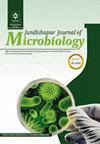Quinolone Resistance in Biofilm-Forming Klebsiella pneumoniae-Related Catheter-Associated Urinary Tract Infections: A Neglected Problem
IF 0.5
4区 医学
Q4 MICROBIOLOGY
引用次数: 0
Abstract
Background: Klebsiella pneumoniae is a bacterium that commonly causes urinary tract infections (UTIs) in hospital settings. The widespread and improper usage of quinolones has increased the resistance rates against these broad-spectrum antibiotics. Objectives: This study aimed to examine the connection between the ability to form biofilms and fluoroquinolone resistance in K. pneumoniae isolated from catheter-associated UTIs. Methods: A total of 110 nonduplicative K. pneumoniae-related catheter-associated UTIs were isolated from three large educational hospitals in Babol, north of Iran. The minimal inhibitory concentration (MIC) of ciprofloxacin was calculated for each detected isolate using the agar dilution procedure. Biofilm production was investigated by a 96-well flat-bottom microtiter plate. The prevalence of gyrA, parC, qnrA, qnrS, acc (6’)-Ib-cr, qepA, qnrB, oqxA, and oqxB genes was evaluated using polymerase chain reaction (PCR). Results: Overall, 28.2% of the strains were resistant to imipenem and considered carbapenem-resistant K. pneumoniae (CRKp). Ciprofloxacin resistance was observed in 66.4%. Moreover, 70% of the isolates produced biofilm. Biofilm production was significantly higher in ciprofloxacin-resistant compared to ciprofloxacin-susceptible strains (P-value < 0.05). Molecular distribution of resistance genes in the 68-fluoroquinolone resistance-Kp strains showed that the prevalence of gyrA, parC, qnrA, qnrS, acc (6’)-Ib-cr, qepA,, qnrB, oqxA, and oqxB genes was 39.7%, 42.6%, 5.9%, 54.4%, 69.1%, 94.1%, 41.2%, 69.1%, and 83.8%, respectively. Conclusions: Our study highlights the high prevalence of plasmid-mediated quinolone resistance genes in clinical samples of K. pneumoniae in the studied region, which is alarming given the possibility of the spread of these pathogens and the few treatments available for infections brought on by multidrug-resistant strains. Moreover, the study characterizes particular mutations in the parC and gyrA genes that cause quinolone resistance.形成生物膜的肺炎克雷伯菌与导尿管相关尿路感染的喹诺酮耐药性:一个被忽视的问题
背景:肺炎克雷伯菌是一种细菌,通常导致尿路感染(uti)在医院设置。喹诺酮类药物的广泛和不当使用增加了对这些广谱抗生素的耐药率。目的:本研究旨在探讨从导管相关uti分离的肺炎克雷伯菌形成生物膜的能力与氟喹诺酮类药物耐药性之间的关系。方法:从伊朗北部巴博勒的三家大型教育医院分离出110例非重复肺炎克雷伯菌相关的导管相关尿路感染。使用琼脂稀释程序计算每个检测到的分离物的环丙沙星的最小抑制浓度(MIC)。采用96孔平板微滴板研究生物膜的生成。采用聚合酶链反应(PCR)检测gyrA、parC、qnrA、qnrS、acc(6’)-Ib-cr、qepA、qnrB、oqxA和oqxB基因的流行情况。结果:总体而言,28.2%的菌株对亚胺培南耐药,认为是碳青霉烯耐药肺炎克雷伯菌(CRKp)。66.4%的患者对环丙沙星耐药。此外,70%的分离菌产生生物膜。环丙沙星耐药菌株的生物膜产量显著高于环丙沙星敏感菌株(p值<0.05)。68株氟喹诺酮耐药kp菌株的耐药基因分子分布显示,gyrA、parC、qnrA、qnrS、acc(6’)-Ib-cr、qepA、qnrB、oqxA和oqxB基因的阳性率分别为39.7%、42.6%、5.9%、54.4%、69.1%、94.1%、41.2%、69.1%和83.8%。结论:我们的研究强调了研究地区肺炎克雷伯菌临床样本中质粒介导的喹诺酮类耐药基因的高流行率,考虑到这些病原体传播的可能性和对多重耐药菌株引起的感染的可用治疗方法很少,这是令人担忧的。此外,该研究还描述了导致喹诺酮类药物耐药性的parC和gyrA基因的特定突变。
本文章由计算机程序翻译,如有差异,请以英文原文为准。
求助全文
约1分钟内获得全文
求助全文
来源期刊

Jundishapur Journal of Microbiology
MICROBIOLOGY-
CiteScore
1.30
自引率
0.00%
发文量
56
审稿时长
6-12 weeks
期刊介绍:
Jundishapur Journal of Microbiology, (JJM) is the official scientific Monthly publication of Ahvaz Jundishapur University of Medical Sciences. JJM is dedicated to the publication of manuscripts on topics concerning all aspects of microbiology. The topics include medical, veterinary and environmental microbiology, molecular investigations and infectious diseases. Aspects of immunology and epidemiology of infectious diseases are also considered.
 求助内容:
求助内容: 应助结果提醒方式:
应助结果提醒方式:


